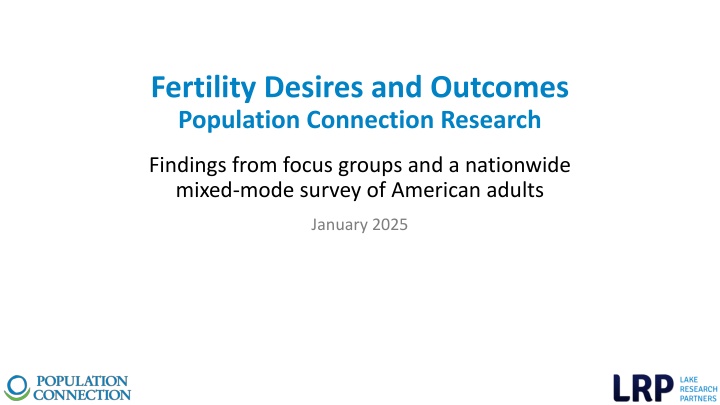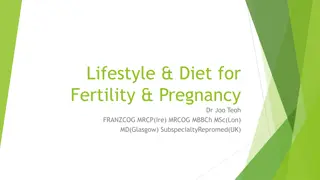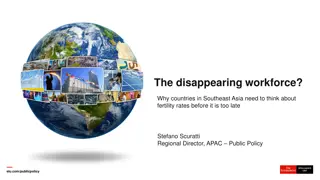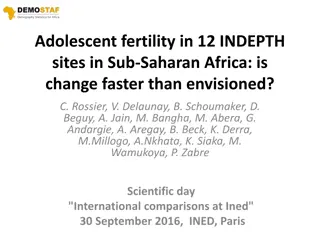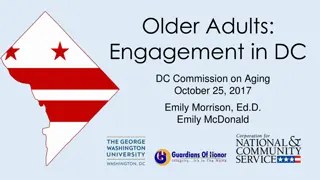Fertility Desires and Outcomes: Research Insights on American Adults
This study delves into the findings from focus groups and a nationwide mixed-mode survey on the connection between fertility desires and outcomes among American adults, providing valuable insights into population trends.
Download Presentation

Please find below an Image/Link to download the presentation.
The content on the website is provided AS IS for your information and personal use only. It may not be sold, licensed, or shared on other websites without obtaining consent from the author.If you encounter any issues during the download, it is possible that the publisher has removed the file from their server.
You are allowed to download the files provided on this website for personal or commercial use, subject to the condition that they are used lawfully. All files are the property of their respective owners.
The content on the website is provided AS IS for your information and personal use only. It may not be sold, licensed, or shared on other websites without obtaining consent from the author.
E N D
Presentation Transcript
Fertility Desires and Outcomes Population Connection Research Findings from focus groups and a nationwide mixed-mode survey of American adults January 2025
Big Picture Findings Parents mostly have about the same number of children they desire, or they desire more children than they have. A plurality of nonparents are not planning to have children, and not wanting kids, affordability, and worries about the state of the world factor into those decisions. More people desire smaller families than larger ones, with most people saying they desire 0-2 children rather than 3 or more. People are split between feeling optimistic or pessimistic about the future of the country and the future for younger generations. For people under 50, worries about the state of the world and being able to afford kids/more kids have had the most significant impact on their ability or decisions to have children. Gen Z adults and women under 50 are also impacted by mental health and worries about abortion and reproductive health care restrictions. Believing that not every woman wants children, and that they should have the opportunity to explore their career and passions is a core value. Few people think women are selfish or have the wrong values if they do not want children. This is also tied to a core value that people should be trusted to make their own decisions about if and when to have children. Personal decision making is important to everyone. People are not buying conservative pronatalist statements about how parents votes should hold more weight than non-parents votes or how a woman s life truly starts when she becomes a wife and a mother.
Key Findings Context A plurality (46%) of nonparents say they do not plan on having children in the future, four in ten (39%) say they do, and 15% don t know, but age impacts these plans. Solid majorities of Gen Z and non-parents ages 18-30 plan on having children in the future. On the other hand, only 15% of parents say they plan on having more children, while eight in ten (79%) say they do not plan on having more children. A plurality (44%) of parents have the same number of children now as their desired number of children, which could be contributing to 79% not planning on having more children, as they already have as many as they want now. Nonparents and parents alike are more interested in having smaller families (0-2 children) than larger families (3+ children). If nonparents were to choose exactly the number of children to have in their whole life, they are most likely to choose to have two children (39%). Notably, just under a quarter (23%) say they would have zero children. Parents are also most likely to say if they could choose exactly the number of children to have in their life, it would be two (34%). Only 6% say they would not have had any children. A majority of both nonparents (65%) and parents (61%) say their desired number of children has stayed about the same over time. Among both parents and nonparents, nearly two in ten (19%) say their desired number has decreased over time. Across demographic subgroups, a majority say their desired number of children has stayed about the same over time. Across demographic subgroups, a majority of adults are pro-choice. Six in ten (63%) consider themselves to be an environmentalist and one in five consider themselves to be strong environmentalists.
Key Findings How People Feel About the Future Adults are split between feeling optimistic and feeling pessimistic about the future of the country (41% optimistic, 39% pessimistic) and the future for younger generations (40% optimistic, 42% pessimistic). A plurality of younger men and women, Gen Z and Millennials, Black and Latino/a adults, Democrats, college-educated adults, and those who are childless but are planning to have kids in the future feel optimistic about the future of the country, whereas a plurality of older women, Boomers, white adults, Republicans, and those who do not plan on having children feel pessimistic. Older men, Gen X, Independents, non-college-educated adults, and adults regardless of their parental status are split between feeling optimistic and pessimistic. A plurality of younger men and women, Millennials, Black and Latino/a adults, Democrats, and college-educated adults feel optimistic about the future for younger generations, while older men and women, Gen X and Boomers, white adults, Republicans, non-college-educated adults, non-parents, and those who do not plan on having children feel pessimistic. Gen Z, Independents, parents, and childless adults who are planning to have kids in the future are split between feeling optimistic and pessimistic.
Key Findings Impacts on Fertility Decisions For people under 50, worries about the state of the world and not being able to afford kids or more kids have had the most significant impacts on their ability or decision to have children (35% and 34% said this had a major impact, respectively). These top impacts on younger people s ability or decision to have children are followed by mental health (27%), being worried about how laws that restrict abortion and reproductive health care will affect them/their partner during pregnancy (25%), age (25%), there not being enough support for parents in our country (22%), and current work demands and schedule making it difficult (22%). Across all subgroups, affordability has had the biggest impact for younger men, Black adults, Gen Z, and childless men and women. Worries about the state of the world has had the biggest impact on younger women, Latino/a adults, Millennials, younger men, childless women, unmarried adults, and those whose desired number of children has decreased. For younger women and Gen Z, mental health is a top tier impact, while worries about laws that restrict abortion and reproductive health care also fall into the top tier for younger women. Those who say they do not plan on having children say not wanting kids has had the biggest impact. Among people over 50, age has had the biggest impact on their ability or decision to have children.
Key Findings Statements Across all respondents, it is a core value that not every woman wants children, and they should have the opportunity to explore their career and passions. When forced to choose between statements that say not every woman wants children (86% side with this statement) and women who do not want children are selfish and do not have the right values (8% side with this statement), people nearly universally side with the former. Across subgroups people agree at high levels with the statement that not every woman wants children. Nearly three-quarters of adults strongly agree that we should trust people to make their own decisions about if and when to have children (73% strongly agree). This is at a core value level of intense agreement. Statements about childbearing trends in the U.S. that four in ten or more intensely agree with are: Sometimes people want to spend their time, energy, and love doing other things than raising children. 48% strongly agree Basics like food and housing cost so much that it forces us to prioritize jobs and income, slowing traditional milestones like having a child. 43% strongly agree When talking about the impacts of climate change on childbearing decisions, more people are concerned about raising children on a planet that is already in trouble than creating another human who will contribute to the destruction of the planet. Either frame works for younger men, Black adults, and Millennials.
Key Findings Population Growth Concerns Around half of adults are very or somewhat concerned about population growth, and global growth is a bigger concern than national growth. 50% said they are very to somewhat concerned about global population growth, while 22% are a little concerned and 24% are not concerned at all 45% said they are very to somewhat concerned about national population growth, while 22% are a little concerned and 29% are not concerned at all. Across subgroups, the most concerning impacts of population growth are more children who live in poverty (36% chose this as a top concern) and the depletion of resources, such as fresh water, forests, and food (30% chose this as a top concern).
Over three-quarters of all adults have smaller families of 0-2 children, while over a third have no children. Less than 10% of adults have larger families of four or more children. Those who have children are most likely to say they have two children. Overall, the most common desired number of children to have among all adults is two children. Around one in five desire three children. Twelve percent of adults would ideally have no children. Only 8% of respondents desire one child.
About half of younger adults do not have any children currently. Younger adults who do currently have children are most likely to have one or two children. For younger adults also, two children is the most desired family size, followed by three and zero, respectively. Only 9% of respondents desire one child.
A plurality of nonparents say they do not plan on having children in the future, four in ten say they do, and 15% dont know. Solid majorities of Gen Z, non-parents ages 18-30, Black men and younger Black non-parents, and Latino men and younger Latino/a non-parents plan on having children in the future. {Nonparents} Do you plan on having children in the future? Most likely to plan on having children in the future Gen Z 67% Under 30 64% Black adults under 50 61% Latino/a adults under 50 59% Black men^ 59% Latino men 55% 39 46 ^ Small sample size 15 Yes No (Don t know)
A majority of younger fathers as well as Gen Z and Millennial parents want more children than the actual number of children they have now. A plurality of younger mothers and Latino/a parents want more children than the actual number of children they have now. On the other hand, a majority of older fathers and Boomer parents have had the same number of children as their desired number. A plurality of older mothers, Gen X parents, and white and Black parents have had the same number of children as their desired number, as have parents across party identification and educational attainment. None of these subgroups are disproportionately likely to say they want fewer children than they have now. {Parents} How many children do you have? If you could go back to the time when you did not have any children and could choose exactly the number of children to have in your life, how many would that be? Want same number as actual number Want fewer children than actual number Want more children than actual number Total Men <50 Women <50 Men 50+ Women 50+ Gen Z Millennial Gen X Boomer White Black Latino/a Democrats Independents Republicans Non-college-educated College-educated 44 34 39 53 48 33 33 42 55 47 42 34 45 44 44 42 47 17 13 16 15 20 10 14 20 17 15 20 23 16 22 16 20 10 39 53 45 31 32 57 53 38 28 38 38 43 40 34 40 37 43
Across demographic subgroups, a majority say their desired number of children has stayed about the same over time. This is especially true for Boomers. Has your desired number of children increased, decreased, or stayed about the same over time? Stayed about the same Increased Decreased Among all adults Men <50 Women <50 Men 50+ Women 50+ Gen Z Millennial Gen X Boomer White Black Latino/a Democrats Independents Republicans Non-college-educated College-educated 20 18 10 13 23 19 16 8 15 15 20 17 15 15 14 20 20 19 19 17 15 22 19 18 20 21 17 18 20 19 19 19 56 60 69 68 57 56 63 72 63 60 59 63 60 64 65 58 62 19 16 3
Some focus group participants say their ideal number of children has changed over time, with almost all saying the number has decreased. They mention reasons like finances/the economy, the difficulty or how taxing pregnancy or birth can be, and the state of the world for why their ideal number has decreased. Mine has changed because my first two trimesters, I was throwing up, like, three times, pregnancy is hard, and it's way harder than I thought it was going to be, and it's way harder than my mom or my auntie said it [was], so for me, it's less." Gen Z woman
Among parents in the focus groups, if they could go back in time when they did not have any children and could choose exactly the number of children to have in their life, many said a number that is less than the number of children they currently have. Some said they would have more. Inflation and personal finances are most often cited as impacting their decisions. The majority of focus group participants think only some people have the number of kids they want to have, with participants citing fertility issues, delayed childbearing, and affordability as limiting factors. I think a lot of people who are perhaps older than us have the [number of] children they want. But I think a lot of people around my age, which is like 20s, maybe early 30s, would maybe have more children if they were more financially stable." Day care is costly. Education is costly. I'm saving for each one of them for their college education right now. Only two [children] instead of five would have been a lot easier. For financial reasons and just the crazy world we live in." Gen Z man Millennial woman
Across most demographic subgroups, a majority of adults are pro-choice. Among demographic subgroups, younger women, Black adults, Democrats, college-educated adults, non-parents, and those who do not plan on having children are most likely to believe abortion should be legal in all cases. The majority of Republicans are anti-choice. Legal in all Pro-choice* Anti-choice** I'm going to read four statements. Listen carefully, then please tell me, which comes closest to your opinion on abortion? Abortion should be... Men <50 Women <50 Men 50+ Women 50+ Gen Z Millennial Gen X Boomer White Black Latino/a Democrats Independents Republicans Non-college-educated College-educated Parents Non-parents 21 32 22 25 29 26 27 22 24 33 25 41 27 8 21 33 22 31 60 73 58 64 67 66 66 60 62 75 69 87 69 38 63 68 62 69 34 22 35 30 26 30 26 35 33 20 23 10 21 55 30 28 32 25 Legal in most cases Illegal in most cases Legal in all cases Illegal in all cases 39 6 65 29 24 25 Plan on having children 22 64 31 Do not plan on having children 38 73 22 6% (don t know/refused) Childless, want kids 27 68 26 * Pro-choice = legal in all cases + legal in most cases ** Anti-choice = illegal in all cases + illegal in most cases
Adults are split between feeling optimistic and pessimistic about the future of the country and the future for younger generations. On a scale that goes from 0 to 10, where 0 means pessimistic and 10 means optimistic, please rate the following. Mean Answered 5 or Don t Know 39 7 9 16 41 5.2 20 How you feel about the future of the country How you feel about the future for younger generations 42 7 9 14 40 5.1 18 0 Pessimistic 1-4 6-7 8-9 10 Optimistic
There are significant differences in peoples outlooks about the future of the country driven by gender and age, generation, race, partisanship, and educational attainment. Optimists about the future of the country include younger men and women, Gen Z and Millennials, Black and Latino/a adults, Democrats, college-educated adults, and those who are childless but are planning to have kids in the future. Pessimists include older women, Boomers, white adults, Republicans, and those who do not plan on having children. Older men, Gen X, Independents, non-college-educated adults, parents, and non-parents are split. 6-10 0-4 Optimistic 46 43 41 35 44 46 38 36 35 56 51 59 39 25 39 45 42 40 34 44 Pessimistic 38 35 40 44 38 35 41 45 45 27 29 24 40 55 40 37 39 39 44 37 On a scale that goes from 0 to 10, where 0 means pessimistic and 10 means optimistic, please rate the following: How you feel about the future of the country Men <50 Women <50 Men 50+ Women 50+ Gen Z Millennial Gen X Boomer White Black Latino/a Democrats Independents Republicans Non-college-educated College-educated Parents Non-parents Do not plan on having children Childless, having kids Mean Feeling: 5.2 41 39 20 16 9 7 Optimistic Pessimistic 5/DK 0 Pessimistic 1-4 6-7 8-9 10 Optimistic The results of the 2024 elections may have shifted partisans outlooks.
Similar patterns emerge when people rate their sentiments toward the future for younger generations. Optimists include younger men and women, Millennials, Black and Latino/a adults, Democrats, and college-educated adults. Pessimists include older men and women, Gen X and Boomers, white adults, Republicans, non-college-educated adults, non-parents, and those who do not plan on having children. Gen Z, Independents, parents, and childless adults who plan on having kids in the future are split. 6-10 0-4 Optimistic 45 44 37 35 43 46 37 35 35 59 46 57 40 25 38 45 43 36 26 40 Pessimistic 40 39 44 45 39 38 44 47 47 23 37 26 38 58 43 39 39 47 55 42 On a scale that goes from 0 to 10, where 0 means pessimistic and 10 means optimistic, please rate the following: How you feel about the future for younger generations Men <50 Women <50 Men 50+ Women 50+ Gen Z Millennial Gen X Boomer White Black Latino/a Democrats Independents Republicans Non-college-educated College-educated Parents Non-parents Do not plan on having children Childless, having kids Mean Feeling: 5.1 42 40 18 14 9 7 Optimistic Pessimistic 5/DK 0 Pessimistic 1-4 6-7 8-9 10 Optimistic The results of the 2024 elections may have shifted partisans outlooks.
Top impacts on fertility decisions by gender and age Age and gender influence the major impacts on people s ability or decision to have children. Worries about the state of the world and affordability are top impacts for younger men and women. Notably, worries about laws that restrict abortion and reproductive health care and mental healthalso fall into a top tier for younger women. Older men and women say age is the biggest impact on their ability or decision to have children, followed distantly by affordability for older men and worries about the world for older women. Now I am going to read you some reasons that may impact people s ability or decision to have children. For each, please tell me how much of an impact this reason has had on you a major impact, somewhat of an impact, a little impact, or no impact at all. Can t afford kids/more kids 34% Worried about the state of the world 33% Men <50 Worried about the state of the world 37% Can t afford kids/more kids 34% Mental health 33% Worried about how laws that restrict abortion and reproductive health care will affect you/your partner during pregnancy 30% Women <50 Age 37% Can t afford kids/more kids 24% Men 50+ Age 42% Worried about the state of the world 30% Women 50+ By % A major impact
Top impacts on fertility decisions by generation Similarly, different generations describe unique reasons that impact their ability or decision to have children. Worries about the state of the world and affordability are top impacts for Gen Z and Millennials. Gen Z also says that mental health is a top tier impact, followed by worries about laws that restrict abortion and reproductive health care. Gen X and Boomers say age is the biggest impact on their ability or decision to have children, followed by secondary impacts of affordability and worries about the world. Now I am going to read you some reasons that may impact people s ability or decision to have children. For each, please tell me how much of an impact this reason has had on you a major impact, somewhat of an impact, a little impact, or no impact at all. Can t afford kids/more kids 40% Worried about the state of the world 35% Mental health 34% Worried about how laws that restrict abortion and reproductive health care will affect you/your partner during pregnancy 30% Gen Z Worried about the state of the world 35% Can t afford kids/more kids 30% Millennial In the focus groups, it was harder for Gen Z men and Millennial men and women to make the connection between people s decisions about having children and abortion/reproductive health care and climate change, while it was easier for Gen Z and Gen X women to make this connection. Age 39% Worried about the state of the world 32% Can t afford kids/more kids 29% Gen X Age 41% Can t afford kids/more kids 23% Worried about the state of the world 22% Boomer By % A major impact
Top impacts on fertility decisions by race Finally, race influences the reasons that impact people s ability or decision to have children. Across race, people say age is a top impact. Black and Latino/a adults also say that affordability has a major impact. Worries about the state of the world are a top impact for white and Latino/a adults. Now I am going to read you some reasons that may impact people s ability or decision to have children. For each, please tell me how much of an impact this reason has had on you a major impact, somewhat of an impact, a little impact, or no impact at all. Age 32% Worried about the state of the world 31% White Can t afford kids/more kids 29% Age 28% Black Worried about the state of the world 35% Age 32% Can t afford kids/more kids 32% Latino/a By % A major impact
When forced to choose between two viewpoints, people nearly universally side with believing that not every woman wants children, and they should have the opportunity to explore their career and passions. Belief in this sentiment is so widespread that thisis a core value. Across demographic subgroups, even among people who hold anti-choice views, people share this perspective. Less than one in ten adults say that women who do not want children are selfish and do not have the right values is closer to their views. Which statement comes closer to your views, even if neither is exactly right? Not every woman 79 88 87 92 85 84 86 92 88 87 81 85 90 84 90 92 87 78 Selfish Women who do not want children are selfish and do not have the right values Men <50 Women <50 Men 50+ Women 50+ Gen Z Millennial Gen X Boomer White Black Latino/a Parents Non-parents Married Unmarried Pro-choice Conflicted Anti-choice 13 8 6 4 10 11 7 3 7 6 11 9 6 11 5 4 8 15 (Don t Know) 8 6 Not every woman wants children, and they should have the opportunity to explore their career and passions 86
Nearly three-quarters of adults strongly agree with a statement that says we should trust people to make their own decisions about if and when to have children. This is a core value. Four in ten or more intensely agree that people may want to spend their time, energy and love doing other things than raising children and that the costs of food and housing being so much that it forces people to prioritize jobs and income over starting a family. Majorities also agree with family bringing meaning to life more than weird little accomplishments and overpopulation increasing unease about raising children on a troubled planet. [TOP TIER] Here are some statements that people have made about childbearing trends in the U.S. and what might be behind them. For each, please tell me if you agree or disagree. Don t Know We should trust people to make their own decisions about if and when to have children. 7 91 3 73 2 Sometimes people want to spend their time, energy, and love doing other things than raising children. 11 85 4 48 4 Basics like food and housing cost so much that it forces us to prioritize jobs and income, slowing traditional milestones like having a child. 17 79 7 43 3 What brings the most meaning to life is family, not all these weird little accomplishments and degrees and everything else.* 28 67 15 36 5 Overpopulation and climate change make us uneasy about raising children on a planet that is already in trouble.* 40 55 24 25 4 Somewhat agree Somewhat disagree Strongly agree Strongly disagree Opposition statements by influential conservative pronatalists *Split sampled
On the other hand, about half or more disagree with statements that assert parents should have more voting power, overpopulation and climate change add to unease about having a child who will contribute to Earth s destruction, becoming a wife and mother truly starts a woman s life, and one of the biggest global challenges is falling fertility rates. [BOTTOM TIER] Here are some statements that people have made about childbearing trends in the U.S. and what might be behind them. For each, please tell me if you agree or disagree. Don t Know When you go to vote in this country, as a parent, you should have more power and more opportunity to speak your voice than people who don t have kids.* 65 30 50 17 5 Overpopulation and climate change make us uneasy about creating another human who will contribute to the destruction of the planet.* 53 42 35 17 5 A woman s life truly starts when she begins living her vocation as a wife and as a mother.* 59 34 41 16 7 Falling fertility rates are one of the biggest challenges facing our world.* 48 37 28 15 15 Somewhat agree Somewhat disagree Strongly agree Strongly disagree Opposition statements by influential conservative pronatalists *Split sampled
Focus Group Methodology On behalf of Population Connection, Lake Research Partners conducted three online focus groups and two in-person focus groups from August 6 12, 2024. Participants for the online groups were recruited nationally, and participants for the in-person groups were recruited from Charlotte, North Carolina, and segmented as follows: Group # Date Location Demographics 1 8/6 Virtual Gen Z women 2 8/6 Virtual Millennial women 3 8/7 Charlotte Gen X women 4 8/7 Charlotte Millennial men 5 8/12 Virtual Gen Z men Participants were recruited to represent a mix of race, educational attainment, urbanicity, marital status, parental status, party identification, ideology, choice stance (excluding those who believe all abortion should be illegal), employment status, household income, importance for all people to have access to reproductive health care, and agreement on whether we must take action to combat climate change (excluding those who strongly disagree). Participants were not invited to participate if they believe all abortion should be illegal, if they are strong Republicans or strong Democrats, if they are very conservative or very liberal, or if they strongly disagree that we must take action to combat climate change.
Qualitative Research Statement of Limitations (Focus Groups) In opinion research, qualitative research seeks to develop insight and direction rather than quantitatively precise or absolute measures. Because of the limited number of respondents and the restrictions of recruiting, this research must be considered in a qualitative frame of reference. The reader may find that some of the information seems inconsistent in character upon first reading this report. These inconsistencies should be considered as valid data from the participant s point of view. That is, the participant may be misinformed or simply wrong in his or her knowledge or judgment, and we should interpret this as useful information about their level of understanding. This study cannot be considered reliable or valid in the statistical sense. This type of research is intended to provide knowledge, awareness, attitudes, and opinions about issues and concerns. The following limitations are inherent in qualitative research and are stated here to remind the reader that the qualitative data presented here cannot be projected to any universe of individuals. Statement 1. Participants who respond to the invitation of a stranger to participate in this research show themselves to be risk takers and may be somewhat more assertive than non-participants. Statement 2. Some participants speak more often and more forcefully in focus group sessions than other participants, so their opinions tend to carry more weight in the findings. Statement 3. Participants self-select themselves. Statement 4. Participants were not selected randomly; as a result, each person in the pool of possible participants did not have an equal chance to be selected.
Survey Methodology Lake Research Partners designed and administered this mixed-mode survey that was conducted from October 3 10, 2024, by contacting participants directly online, via text message (a portion of the sample received a text to their cell phone with a link to complete the survey online), and by phone using professional telephone interviewers. The survey reached a total of 1,418 adults nationwide, which included a representative base of 1,018 plus oversamples of 100 Black adults, 100 Latino/a adults, 100 Generation Z adults, and 100 Millennial adults. The oversamples were weighed down into their respective base samples to their proper proportion of the universe. The margin of error for the base sample is +/-2.6%; the margin of error is higher among subgroups. Quantitative results are expressed as percentages unless otherwise noted. Results may not add up to 100% due to rounding or multiple responses.
Demographics of Adults Surveyed Age Education Region Under 30 High school or less New England 22 21 5 30-39 Post-H.S. / Some College Middle Atlantic 16 43 13 40-49 College graduate East North Central 17 21 14 50-64 Post-graduate West North Central 25 14 6 65+ South Atlantic 18 20 East South Central Gender 6 Party Identification Men West South Central 48 12 44 Democrat Women Mountain 51 7 Independent/DK 11 Nonbinary Pacific 1 16 Republican 38 Marital Status Household Income Race Married 49 Below $50,000 33 White 62 Unmarried w/ Partner 10 Above $50,000 60 Black 13 Single 24 Latino/a 17 Separated/Divorced 9 Children in Household Growing Up Asian American or Pacific Islander 5 Widowed 5 Native or Indigenous American 1-3 children 1 60 Middle Eastern or North African 4+ children 0 38
Demographics of Adults Surveyed How Many Children 1 27 2 39 Parental Status 3 20 Fathers 29 4 8 Mothers 34 5-8 5 Childless men 19 9+ 0 Childless women 17 1-3 86 Parents 63 4+ 14 Parents of children under 18 33 Parents of children 18 or 33 Age of Children older 0-4 34 Nonparents 37 5-11 48 12-14 26 15-17 27
Washington, DC | Berkeley, CA | New York, NY lakeresearch.com | 202.776.9066 Population Connection is the largest grassroots population organization in the United States, educating young people and advocating progressive action to stabilize world population at a level that can be sustained by Earth s resources. populationconnection.org 2120 L Street NW, Suite 500 Washington, DC 20037 Marian Starkey Vice President for Communications Population Connection mstarkey@popconnect.org 202.974.7735 Olivia Nater Communications Manager Population Connection onater@popconnect.org 202.974.7739
